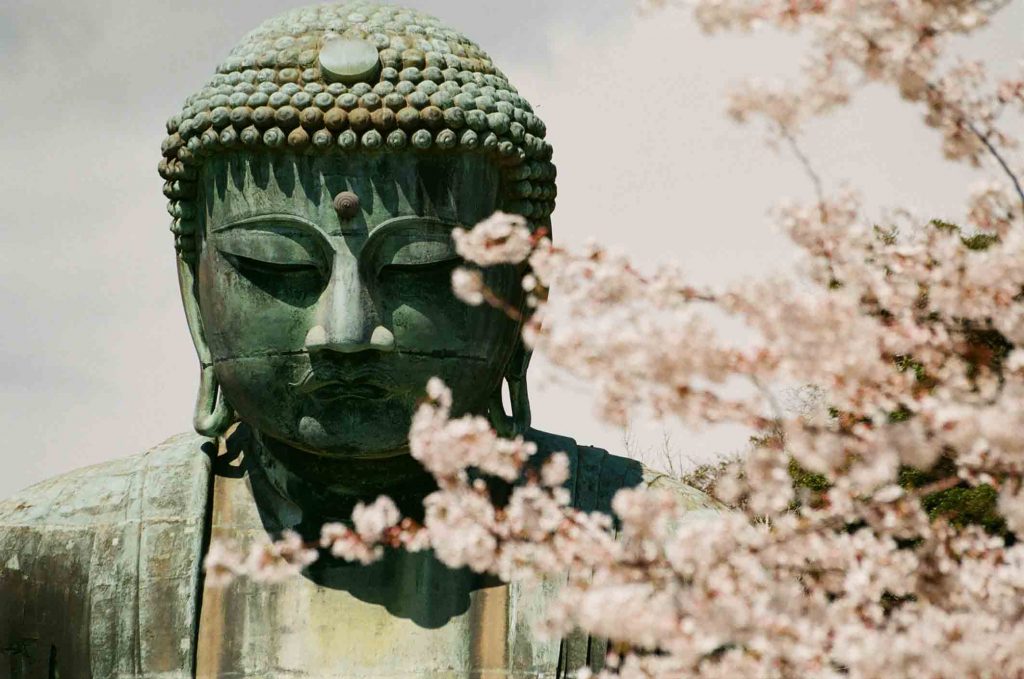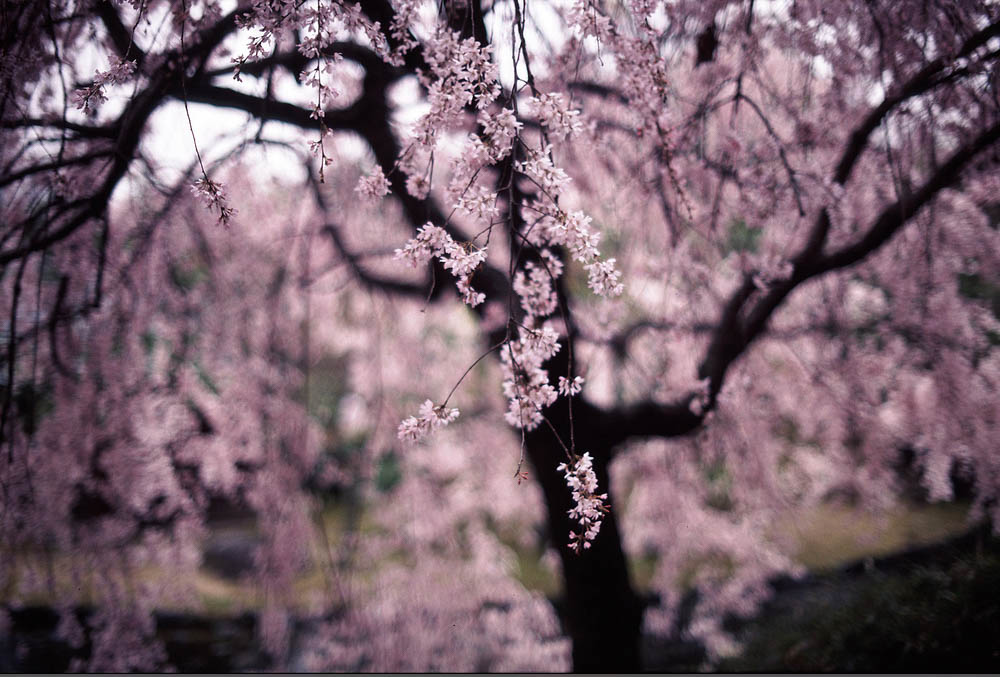Japan is hands-down one of the most beautiful countries to visit during any time of the year. It’s an absolute showstopper during the gorgeous cherry blossom season, it’s magical when blanketed in fresh snowfall during winter, but it’s also a head-turner when the multi-coloured autumn leaves are floating through the air during the autumn foliage fall, and it absolute shines in summer when the stunning beaches come under the spotlight.
Japan during all seasons is #worthit, and so fear not if you can’t take time off during the traditionally super popular cherry blossom season that everyone seems to be talking about, because sometimes traveling off the beaten path (or in this instance, off the beaten peak period), is quite a pleasant surprise for the soul. Read on as we cover all that you can expect and experience in each season of Japan.
Spring and the Cherry Blossoms

Undoubtedly the most popular season to visit Japan, spring is a time that many people associate with sakura blooms, gorgeously curated pictures, comfortable neutral sunny weather, and fun. We can completely attest to that. Spring is one of the best times to visit not only because of how picturesque the country becomes, but it is also when the weather is the best to go exploring.
Whilst it’s still coming out of winter and might be a tad chilly at night, during the day you can wear comfortable clothing (i.e. not have to rug up in an uncomfortable number of layers), and at night you don’t have to have the heater or air con blasting.
It’s a great time to spend your exploration days on foot (which we highly recommend – Japan’s famous for having attractions within very close proximity to each other, making it easy for tourists to access).

There are other (very unique) elements of the spring cherry blossom season that make it so popular amongst tourist. For example, the reigning champion fruit in Japan in Spring is strawberries, and you can bet they come out in abundance during this period.
You can participate in strawberry picking and take home a load of the thick and sweet fruits for consumption over a few days, or you can purchase them at the shops – during this time, all supermarkets and fruit stores will be overflowing with the gorgeous fruit, packaged in a way that’s perfect to take on a cherry blossom viewing picnic.
On the topic of food, during the cherry blossom season, cafes and restaurants often pull out all stops, offering limited edition sakura shaped and flavoured dishes across the country for visitors and locals to sample and get into the swing of things. It’s like a festival that’s celebrated across the entire nation, and you’ll love being in the midst of it.

Spring offers so many reasons why it’s the most popular season in Japan, and you can read more about it here, where we’ve detailed what the season is like and what else you can expect: Sakura Japan and Cherry Blossom Festival.
Autumn and the Momiji

The months of autumn (i.e. September – November) is another great time to travel Japan if you’re looking forward to doing a lot of outdoor activities. The weather would just be cooling down from the hot summer, but it won’t be sub-arctic, so you can still wear comfortable clothing throughout the day to go exploring.

If you are traveling during autumn, we highly recommend at least a few hikes and outdoor adventures to truly experience the famous autumn foliage that many travelers are starting to realize about Japan.
Named ‘Koyo’, the scene of millions of burnt orange leaves flying through the air and blanketing the ground is something that the Japanese people absolutely adore, and some plans trips around this time to famous mountains to be able to capture its beauty – this activity is called ‘momiji-gari’, which literally translates to ‘hunting red leaves’.
Unlike the cherry blossoms, in which the season only lasts roughly two weeks, the falling of the leaves lasts for around 50 days or so, making the time of traveling to Japan for this phenomenon much more flexible.

Some of our favourite places to check out the foliage in Tokyo include Yoyogi Park, Shinjuku Gyoen, and Mount Takao.
To find out more about visiting Japan in Autumn, check out this link where we detailed the foliage forecast and the best spots to see the Momiji city by city: Autumn in Japan.
Summer In Japan

Summer in Japan is, quite frankly, very hot. It sometimes reaches past 30 degrees, which is normally quite acceptable in most countries, however the humidity levels in Japan are definitely something that most people aren’t use to.
Unlike the dry hot summers most travellers imagine, summer in Japan is the type to make you break into an uncomfortable sweat the moment you walk outside the hotel doors; you’ll be smart to bring a bottle of water and a small towel everywhere you go; make sure you’re not wear satin because it will stain with your perspiration.

In saying that, the great thing about traveling during summer is the Japanese beaches. Sounds unusual right? Most people don’t hype up the beaches there because they’ve probably never been, but Japanese beaches are something of a wonder, especially if you travel west to the Okinawan Islands.
Imagine a little tropical getaway in Japan – it’s completely off everyone’s radar. It’s almost completely tourist free during most of the year, and unlike any other paradise you’ve ever known. Read more about Okinawa here: Okinawa Japan.

Another reason why traveling in Summer is great because it will give you an excuse to consume unlimited, copious amounts of desserts, something that Japan is particularly known for. Their parfaits are out-of-this-world, with creativity always coming into play to make your next sundae the absolutely cutest thing you’ll ever lay your eyes on.
They have ice cream parlours sprinkled all across the country offering unique flavours such as level 10 matcha and Hokkaido milk. They have iced beverages that are crafted with such talent and tender loving care that you’ll most certainly be back for seconds at at least one café or another. Japan’s dessert game is strong, and with the sun’s heat beating on your back, there’s no reason why you wouldn’t stop at every second store to sample something delicious.
Last but not least, Summer is also the best season to climb to the top of the gorgeous Mount Fuji. More info here: Climbing Mt Fuji.
If you want to know more about this season, you can read this article: Pros and Cons to Travel to Japan in Summer.
How About Winter?

Winter in Japan is pretty much the definition of a winter wonderland. The snowy landscapes that you experience in this country is absolutely breathtaking, and worth traveling in sometimes 0-degree weather. Many people have heard about the snow in Japan being some of the best in the world, and we can attest to the fact that the snow here is as soft as flour and as white as cotton, and it’s something everyone should experience at least once in their lives.

Whilst majority of the country pretty much becomes like a city within a snow globe during winter, there are some areas that experience more snowfall than others, and it is those ones that you should keep in mind to visit outside of the normal tourist areas.
They include, but are not limited to, the entire Hokkaido island up north (but more specifically Asahikawa and Sapporo), Zao Onsen Ski Resort (located in Miyagi), Shirakawago (central Japan), Aomori, Ginzan Onsen (Yamagata), and the Kamakura festivals across Tohoku, just to name a few.
Which ones you visit will depend on what type of traveller you are, however, just prepare yourselves for absolute raw beauty. Wake up a little earlier to experience the snow in silence, that’s something we recommend you do at least once.

If you’re the type of traveller to get cold easily, then we definitely urge you to pull out all stops and rug up as best as you can, because the cold here can get pretty chilly. You may think that the cities which don’t usually experience snowfall may be a tad warmer and thus you should layer less but we absolutely implore that you clad yourself in as much heat-tech gear as possible because if you catch a cold at the beginning of your trip, that would be the biggest bummer.
When we say rug up, we mean everywhere, the whole shebang – gloves, woollen socks, beanies, scarves, thermals, don it all. To find out more about winter in Japan, such as how to combat the cold and the best places to visit, check out our Winter in Japan article.
As big advocates of Japan as a country, we can’t fault visiting the country during any time of the year in any way. You will easily find fun, exciting, and sometimes even free activities to do despite whatever weather you’re experiencing, because Japan is that rich in culture of a country. Some people are summertime travellers, whilst others enjoy the chilly breeze of winter winds, and Japan’s a unique country in that it can cater to all travellers equally with its raw nature and neon-lit city-scapes.
To finish this article, let me remind you that you can find all our travel tips about Japan here: Japan Travel Blog.
And don’t forget to join our Facebook Group to share and get useful info about traveling to Japan and everywhere else in Asia!

